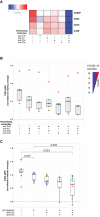This is a preprint.
Signaling through FcγRIIA and the C5a-C5aR pathway mediates platelet hyperactivation in COVID-19
- PMID: 33972943
- PMCID: PMC8109205
- DOI: 10.1101/2021.05.01.442279
Signaling through FcγRIIA and the C5a-C5aR pathway mediates platelet hyperactivation in COVID-19
Update in
-
Signaling Through FcγRIIA and the C5a-C5aR Pathway Mediate Platelet Hyperactivation in COVID-19.Front Immunol. 2022 Mar 3;13:834988. doi: 10.3389/fimmu.2022.834988. eCollection 2022. Front Immunol. 2022. PMID: 35309299 Free PMC article.
Abstract
Patients with COVID-19 present with a wide variety of clinical manifestations. Thromboembolic events constitute a significant cause of morbidity and mortality in patients infected with SARS-CoV-2. Severe COVID-19 has been associated with hyperinflammation and pre-existing cardiovascular disease. Platelets are important mediators and sensors of inflammation and are directly affected by cardiovascular stressors. In this report, we found that platelets from severely ill, hospitalized COVID-19 patients exhibit higher basal levels of activation measured by P-selectin surface expression, and have a poor functional reserve upon in vitro stimulation. Correlating clinical features to the ability of plasma from COVID-19 patients to stimulate control platelets identified ferritin as a pivotal clinical marker associated with platelet hyperactivation. The COVID-19 plasma-mediated effect on control platelets was highest for patients that subsequently developed inpatient thrombotic events. Proteomic analysis of plasma from COVID-19 patients identified key mediators of inflammation and cardiovascular disease that positively correlated with in vitro platelet activation. Mechanistically, blocking the signaling of the FcγRIIa-Syk and C5a-C5aR pathways on platelets, using antibody-mediated neutralization, IgG depletion or the Syk inhibitor fostamatinib, reversed this hyperactivity driven by COVID-19 plasma and prevented platelet aggregation in endothelial microfluidic chamber conditions, thus identifying these potentially actionable pathways as central for platelet activation and/or vascular complications in COVID-19 patients. In conclusion, we reveal a key role of platelet-mediated immunothrombosis in COVID-19 and identify distinct, clinically relevant, targetable signaling pathways that mediate this effect. These studies have implications for the role of platelet hyperactivation in complications associated with SARS-CoV-2 infection.
One-sentence summary: The FcγRIIA and C5a-C5aR pathways mediate platelet hyperactivation in COVID-19.
Conflict of interest statement
Figures





References
-
- Zhou F., Yu T., Du R., Fan G., Liu Y., Liu Z., Xiang J., Wang Y., Song B., Gu X., Guan L., Wei Y., Li H., Wu X., Xu J., Tu S., Zhang Y., Chen H., Cao B., Clinical course and risk factors for mortality of adult inpatients with COVID-19 in Wuhan, China: a retrospective cohort study, Lancet 395, 1054–1062 (2020). - PMC - PubMed
-
- Huang C., Wang Y., Li X., Ren L., Zhao J., Hu Y., Zhang L., Fan G., Xu J., Gu X., Cheng Z., Yu T., Xia J., Wei Y., Wu W., Xie X., Yin W., Li H., Liu M., Xiao Y., Gao H., Guo L., Xie J., Wang G., Jiang R., Gao Z., Jin Q., Wang J., Cao B., Clinical features of patients infected with 2019 novel coronavirus in Wuhan, China, Lancet 395, 497–506 (2020). - PMC - PubMed
-
- Stadlbauer D., Amanat F., Chromikova V., Jiang K., Strohmeier S., Arunkumar G. A., Tan J., Bhavsar D., Capuano C., Kirkpatrick E., Meade P., Brito R. N., Teo C., McMahon M., Simon V., Krammer F., SARS-CoV-2 Seroconversion in Humans: A Detailed Protocol for a Serological Assay, Antigen Production, and Test Setup, Curr. Protoc. Microbiol. 57, e100 (2020). - PMC - PubMed
-
- Middeldorp S., Coppens M., van Haaps T. F., Foppen M., Vlaar A. P., Müller M. C. A., Bouman C. C. S., Beenen L. F. M., Kootte R. S., Heijmans J., Smits L. P., Bonta P. I., van Es N., Incidence of venous thromboembolism in hospitalized patients with COVID-19, J. Thromb. Haemost. 18, 1995–2002 (2020). - PMC - PubMed
Publication types
Grants and funding
- R01 HL137006/HL/NHLBI NIH HHS/United States
- T32 CA009140/CA/NCI NIH HHS/United States
- F99 CA234842/CA/NCI NIH HHS/United States
- K08 CA230157/CA/NCI NIH HHS/United States
- K00 CA234842/CA/NCI NIH HHS/United States
- P01 HL040387/HL/NHLBI NIH HHS/United States
- R01 AI105343/AI/NIAID NIH HHS/United States
- R35 HL150698/HL/NHLBI NIH HHS/United States
- T32 AR076951/AR/NIAMS NIH HHS/United States
- K08 AI136660/AI/NIAID NIH HHS/United States
- R01 HL137915/HL/NHLBI NIH HHS/United States
- T32 HL007586/HL/NHLBI NIH HHS/United States
- R38 HL143613/HL/NHLBI NIH HHS/United States
- P01 HL120846/HL/NHLBI NIH HHS/United States
LinkOut - more resources
Full Text Sources
Other Literature Sources
Miscellaneous
